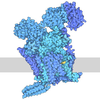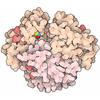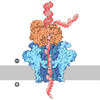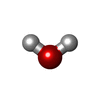Entry Database : PDB / ID : 4pqdTitle The longer crystal structure of the grow factor like domain from Beta amypoid precusor protein (APP22-126) Amyloid beta A4 protein Keywords / / / / / Function / homology Function Domain/homology Component
/ / / / / / / / / / / / / / / / / / / / / / / / / / / / / / / / / / / / / / / / / / / / / / / / / / / / / / / / / / / / / / / / / / / / / / / / / / / / / / / / / / / / / / / / / / / / / / / / / / / / / / / / / / / / / / / / / / / / / / / / / / / / / / / / / / / / / / / / / / / / / / / / / / / / / / / Biological species Homo sapiens (human)Method / / / Resolution : 1.332 Å Authors Tan, X. / Li, W. / Wang, Z. Journal : To be Published Title : Mapping the interaction betwwen APP and DR6Authors : Tan, X. / Li, W. / Wang, Z. History Deposition Mar 2, 2014 Deposition site / Processing site Revision 1.0 Apr 8, 2015 Provider / Type Revision 1.1 Oct 9, 2024 Group / Database references / Structure summaryCategory chem_comp_atom / chem_comp_bond ... chem_comp_atom / chem_comp_bond / database_2 / pdbx_entry_details / pdbx_modification_feature Item / _database_2.pdbx_database_accession
Show all Show less
 Yorodumi
Yorodumi Open data
Open data Basic information
Basic information Components
Components Keywords
Keywords Function and homology information
Function and homology information Homo sapiens (human)
Homo sapiens (human) X-RAY DIFFRACTION /
X-RAY DIFFRACTION /  SYNCHROTRON /
SYNCHROTRON /  MOLECULAR REPLACEMENT / Resolution: 1.332 Å
MOLECULAR REPLACEMENT / Resolution: 1.332 Å  Authors
Authors Citation
Citation Journal: To be Published
Journal: To be Published Structure visualization
Structure visualization Molmil
Molmil Jmol/JSmol
Jmol/JSmol Downloads & links
Downloads & links Download
Download 4pqd.cif.gz
4pqd.cif.gz PDBx/mmCIF format
PDBx/mmCIF format pdb4pqd.ent.gz
pdb4pqd.ent.gz PDB format
PDB format 4pqd.json.gz
4pqd.json.gz PDBx/mmJSON format
PDBx/mmJSON format Other downloads
Other downloads 4pqd_validation.pdf.gz
4pqd_validation.pdf.gz wwPDB validaton report
wwPDB validaton report 4pqd_full_validation.pdf.gz
4pqd_full_validation.pdf.gz 4pqd_validation.xml.gz
4pqd_validation.xml.gz 4pqd_validation.cif.gz
4pqd_validation.cif.gz https://data.pdbj.org/pub/pdb/validation_reports/pq/4pqd
https://data.pdbj.org/pub/pdb/validation_reports/pq/4pqd ftp://data.pdbj.org/pub/pdb/validation_reports/pq/4pqd
ftp://data.pdbj.org/pub/pdb/validation_reports/pq/4pqd Links
Links Assembly
Assembly
 Components
Components Homo sapiens (human) / Gene: APP, A4, AD1 / Production host:
Homo sapiens (human) / Gene: APP, A4, AD1 / Production host: 
 X-RAY DIFFRACTION / Number of used crystals: 1
X-RAY DIFFRACTION / Number of used crystals: 1  Sample preparation
Sample preparation SYNCHROTRON / Site:
SYNCHROTRON / Site:  SSRF
SSRF  / Beamline: BL17U / Wavelength: 0.9793 Å
/ Beamline: BL17U / Wavelength: 0.9793 Å Processing
Processing MOLECULAR REPLACEMENT / Resolution: 1.332→27.23 Å / SU ML: 0.1 / σ(F): 1.34 / Phase error: 17.48 / Stereochemistry target values: ML
MOLECULAR REPLACEMENT / Resolution: 1.332→27.23 Å / SU ML: 0.1 / σ(F): 1.34 / Phase error: 17.48 / Stereochemistry target values: ML Movie
Movie Controller
Controller






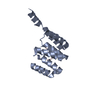




 PDBj
PDBj






